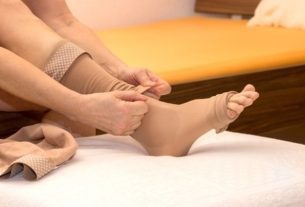Surgery for carpal tunnel syndrome is indicated in cases where treatment with medications, immobilizers and physiotherapy do not improve symptoms or when there is significant compression on the nerve.
This surgery aims to release the median nerve that is being pressed in the wrist region, relieving the symptoms of carpal tunnel syndrome, such as tingling or stinging sensations in the hand and fingers. Check out the main symptoms of carpal tunnel syndrome.
Surgery for carpal tunnel syndrome is performed by an orthopedist, and is simple, can be performed under local or general anesthesia, and promotes a complete and permanent cure. It is important that the person keeps their wrist immobilized and remains with their hand raised for approximately 48 hours to make recovery easier.

When is it indicated
Surgery for carpal tunnel syndrome is indicated in the following situations:
- Lack of pain improvement with conservative treatmentwhich includes rest, wrist braces, analgesic or anti-inflammatory medications, physiotherapy or corticosteroid injections;
- Severe symptoms due to strong compression of the median nerve.
This surgery allows the transverse carpal ligament to be released, which reduces pressure on the median nerve, which passes through the wrist and innervates the palm of the hand, relieving symptoms and allowing the cure of carpal tunnel syndrome.
Surgery for carpal tunnel syndrome must be carried out with the recommendation of an orthopedist, and can be performed by an orthopedic surgeon, neurosurgeon or hand surgeon.
Make an appointment with an orthopedist in the nearest region:
Taking care of your health has never been easier!
How to prepare for surgery
To prepare for surgery, it is important to clarify with the doctor all doubts about the surgery, technique to be performed, risks, complications, recovery and expectations, and carry out surgical risk tests. See the main surgical risk exams.
It is important to inform the doctor of all health problems, in addition to allergies and medication use, as the doctor may recommend stopping the use of anticoagulants for a few days before surgery to avoid bleeding or hemorrhaging.
The day before surgery, you must fast for at least 8 hours, as advised by your doctor.
How it is made
Surgery for carpal tunnel syndrome is performed by an orthopedic surgeon, neurosurgeon or hand surgeon, in the hospital, with general anesthesia, however, it can also be performed with local anesthesia and sedation, using different techniques.
To perform the surgery, the doctor must follow some steps:
- Make a cut in the skinbetween the palm of the hand and the fist;
- Cut the ligament of the carpus;
- Close the cut in the skin with dots;
- Putting on a bandage no local;
- Bandage or splint to avoid moving the handle.
Surgery for carpal tunnel lasts around 30 minutes, with no need for hospital admission, and the person is released on the same day to return home.
Types of carpal tunnel surgery
The surgery can be performed with two different techniques:
- Traditional technique: the surgeon makes a large cut in the palm of the hand over the carpal tunnel and makes a cut in a membrane of the hand, the middle palmar aponeurosis, decompressing the nerve;
- Endoscopic technique: The surgeon uses a device with a small camera attached to see inside the carpal tunnel and makes an incision in the middle palmar aponeurosis, decompressing the nerve.
In all cases, anesthesia is used so that the person does not feel pain during the procedure.
What is recovery like?
Recovery time varies depending on the type of technique used, but generally the recovery time for traditional surgery is slightly longer than the recovery time for endoscopic surgery.
In general, people who work in offices and have to type need to stay away from work for up to 21 days.
Care after surgery
After carpal tunnel surgery, it is important to take some precautions for a good recovery, such as:
- Stay at rest and avoid activities that require the use of the hand for at least the first 2 weeks;
- Keep the cut on your skin always clean and dryto avoid infections;
- Take medications prescribed by your doctorsuch as paracetamol or ibuprofen, to relieve pain and discomfort;
- Keep the operated hand raised for 48 hours to help reduce any swelling and stiffness in your fingers;
- Use a splint to immobilize the wrist to prevent damage caused by joint movement for 8 to 10 days;
- Place an ice pack on the area to relieve pain and reduce swelling, only after removing the splint.
It is normal that in the first few days after surgery you may feel pain or weakness that may take a few weeks or even months to go away, however, the person can, with the doctor’s guidance, continue to use their hand to do light activities that do not cause pain. or discomfort.
After surgery, it is usually necessary to do a few more physiotherapy sessions for the carpal tunnel and exercises to prevent the surgery scars from adhering and preventing the free movement of the affected nerve. See some examples of exercises to do at home.
Check out other tips in the following video:
Possible complications
Despite being a simple and safe surgery, carpal tunnel surgery can also present some risks, such as infection, bleeding, nerve damage and persistent pain in the wrist or arm.
Furthermore, in some cases it is possible that, after surgery, symptoms such as tingling and the feeling of needles in the hand do not completely disappear and may return.
Bibliography
- IZMALKOV, SN; et al. Carpal tunnel syndrome: Does preoperative disease severity influence the outcome of mini-open surgery?. Hand Surg Rehabil. 41. 4; 470-476, 2022
- FERNÁNDEZ-DE-LAS PEÑAS, C.; et al. Manual Physical Therapy Versus Surgery for Carpal Tunnel Syndrome: A Randomized Parallel-Group Trial. J Pain. 16. 11; 1087-94, 2015
- ORHURHU, V.; et al. Carpal Tunnel Release Surgery- A Systematic Review of Open and Endoscopic Approaches. Anesth Pain Med. 10. 6; e112291, 2020
- FERNANDES, CH; et al. Failure factors for carpal tunnel syndrome surgical treatment: When and how to perform a revision carpal tunnel decompression surgery. Rev Bras Ortop (Sao Paulo). 57. 5; 718–725, 2022
- CALANDRUCCIO, JH; THOMPSON, NB Carpal Tunnel Syndrome: Making Evidence-Based Treatment Decisions. Orthop Clin North Am. 49. 2; 223-229, 2018
- SEVY, J. O.; VARACALLO, M. IN: STATPEARLS (INTERNET). TREASURE ISLAND (FL): STATPEARLS PUBLISHING. Carpal Tunnel Syndrome. 2022. Available at: <https://www.ncbi.nlm.nih.gov/books/NBK448179/>. Accessed on November 7, 2023
- BRAZILIAN SOCIETY OF PLASTIC SURGERY. Learn about surgery for carpal tunnel syndrome. Available at: <https://sbcp-sc.org.br/artigos/conheca-cirurgia-para-sindrome-tunel-carpo/>. Accessed on January 14, 2021
- BRAZILIAN SOCIETY OF HAND SURGERY. Find out what carpal tunnel syndrome is, how to treat and prevent the condition. Available at: <https://www.cirurgiadamao.org.br/imprensa-midia-exibir.php?id=45>. Accessed on January 14, 2021

Sign up for our newsletter and stay up to date with exclusive news
that can transform your routine!
Warning: Undefined array key "title" in /home/storelat/public_html/wp-content/plugins/link-whisper-premium/templates/frontend/related-posts.php on line 12
Warning: Undefined array key "title_tag" in /home/storelat/public_html/wp-content/plugins/link-whisper-premium/templates/frontend/related-posts.php on line 13




